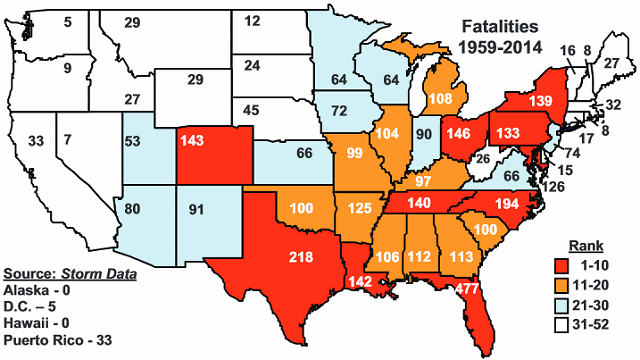20th Annual Lightning Safety Awareness Week
June 21 - 27 marked the 20th annual week dedicated to educating people about the dangers of lightning.
•
Jun 22, 2020, 3:08 PM
•
Updated 1,958 days ago
Share:

Have you ever heard the saying "WHEN THUNDER ROARS, GO INDOORS!" ?
It was a slogan created for good reason, as lightning is one of the deadliest weather phenomena - beaten out by only tornadoes and flooding.
National Lightning Safety Awareness week was started in 2001 to call attention to this underrated killer. Since then, U.S. lightning fatalities have dropped from about 55 per year to less than 30. The reduction in fatalities can certainly be attributed to greater awareness of the dangers of lightning, leading people to seek safety during thunderstorms.
The probability of being struck by lightning in any given year is roughly 1 in 1.2 million, and the odds of being struck in your entire lifetime are about 1 in 15,000. These statistics are based on averages from 2009 through 2018, and are actually significantly more favorable for being struck (1 in 700,000 and 1 in 3,000, respectively) than in decades prior - yet another positive result from increased awareness.
As is the case with most weather awareness weeks, each day is designated a different topic of lightning safety:
- Sunday: An Introduction to Lightning and Lightning Safety
- Monday: The Science of Lightning and Thunder
- Tuesday: Lightning Safety Outdoors
- Wednesday: Lightning Safety Indoors
- Thursday: Lightning Safety and Sports Activities
- Friday: Medical Effects on Lightning Victims
- Saturday: Protecting Your Home from Lightning
You may think that living in the Northeast presents much less of a lightning risk than other areas of the country. Think again. From 1959 to 2014, New York ranks eight in lightning fatalities, while New Jersey ranks 24th. While these numbers can partially be attributed to state size and population, we unquestionably see a good deal of electric storms throughout the year.

image courtesy: NOAA
Another important area of discussion is lightning misinformation. Let's look into a few popular myths.
First, did you know that rubber shoes and rubber tires on a car do nothing to protect you from lightning? The rubber on your shoes is way too thin to offer any protection from a bolt of lightning, and the reason you are protected in your car is actually because of the metal frame of the vehicle, which channels the lightning around you and ultimately into the ground.
You've probably heard of the saying "lightning never strikes twice." Well, not only is that false, but it happens often! Especially high structures.
Another myth is someone struck by lightning temporarily holds an electric charge and can harm you if you touch them - wrong! You can (and should) help them immediately. Medical care may be needed immediately to save the person's life.
Lastly, some think that if the sky is blue, lightning cannot hurt you. This is not always true, as lightning can strike from many miles away. A good rule of thumb is the 30-30 rule. When you see a flash of lightning, count how much time elapses until you hear thunder. If that time is 30 seconds or less, the thunderstorm is within 6 miles of your location and is potentially dangerous.
For more information, visit lightningsafetycouncil.org!
More from News 12

16-year-old from The Bronx fatally shot in Crown Heights
1:29

Seasonable temps on mostly sunny Sunday in The Bronx

Man stabbed multiple times in Baychester
1:55

‘Boots on the Ground’ free breakfast sees long line amid uncertainty surrounding SNAP benefits
1:47

Remembering Kristjan: Pickleball tourney marks 10 years since Halloween crash killed 3 in Pelham Bay
0:35
